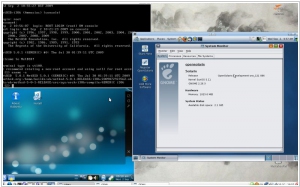KVM vs oVirt
July 23, 2023 | Author: Michael Stromann
16

KVM (for Kernel-based Virtual Machine) is a full virtualization solution for Linux on x86 hardware containing virtualization extensions (Intel VT or AMD-V). It consists of a loadable kernel module, kvm.ko, that provides the core virtualization infrastructure and a processor specific module, kvm-intel.ko or kvm-amd.ko. KVM also requires a modified QEMU although work is underway to get the required changes upstream.
KVM (Kernel-based Virtual Machine) and oVirt are both virtualization technologies, but they serve different purposes and have distinct functionalities. KVM is an open-source virtualization module that is built into the Linux kernel, enabling the host system to act as a hypervisor. It provides the core virtualization capabilities, such as hardware-assisted virtualization and memory management, to create and manage virtual machines (VMs). However, KVM lacks a comprehensive management interface, which means users need to interact with the command line or use external tools for virtual machine administration.
On the other hand, oVirt is a complete virtualization management platform built on top of KVM. It offers a centralized web-based management interface to create, configure, and monitor VMs and their resources. oVirt provides a range of features, including live migration, high availability, storage management, and networking capabilities. With oVirt, administrators can efficiently manage multiple hosts and VMs from a single interface, making it an ideal solution for organizations seeking a robust and user-friendly virtualization management solution.
The key difference between KVM and oVirt, therefore, lies in their scope and functionality. KVM is the underlying virtualization technology that provides hardware-level virtualization capabilities, while oVirt acts as a comprehensive management layer that harnesses KVM's capabilities and adds more features for easier and more efficient VM management. While KVM alone may be suitable for experienced users who prefer working with the command line and have basic virtualization needs, oVirt is better suited for businesses and enterprises that require a feature-rich, centralized management platform for their virtualized infrastructure.
See also: Top 10 Virtualization platforms
On the other hand, oVirt is a complete virtualization management platform built on top of KVM. It offers a centralized web-based management interface to create, configure, and monitor VMs and their resources. oVirt provides a range of features, including live migration, high availability, storage management, and networking capabilities. With oVirt, administrators can efficiently manage multiple hosts and VMs from a single interface, making it an ideal solution for organizations seeking a robust and user-friendly virtualization management solution.
The key difference between KVM and oVirt, therefore, lies in their scope and functionality. KVM is the underlying virtualization technology that provides hardware-level virtualization capabilities, while oVirt acts as a comprehensive management layer that harnesses KVM's capabilities and adds more features for easier and more efficient VM management. While KVM alone may be suitable for experienced users who prefer working with the command line and have basic virtualization needs, oVirt is better suited for businesses and enterprises that require a feature-rich, centralized management platform for their virtualized infrastructure.
See also: Top 10 Virtualization platforms




